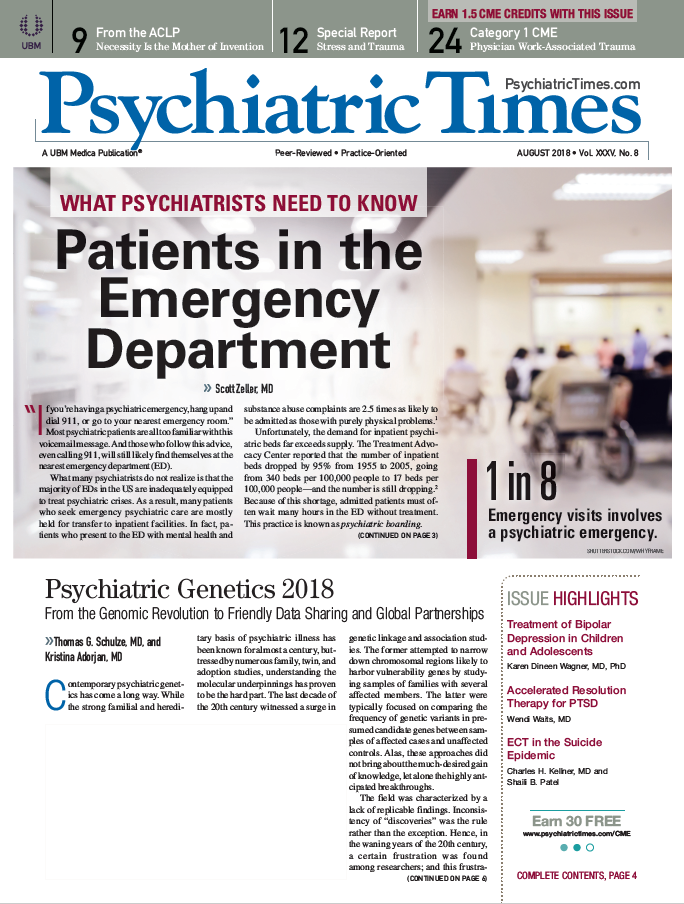Publication
Article
Psychiatric Times
What Psychiatrists Need to Know: Patients in the Emergency Department
Author(s):
If an appropriate treatment is started promptly, the majority of psychiatric emergencies can be resolved within 24 hours without inpatient hospitalization.

If you’re having a psychiatric emergency, hang up and dial 911, or go to your nearest emergency room.” Most psychiatric patients are all too familiar with this voicemail message. And those who follow this advice, even calling 911, will still likely find themselves at the nearest emergency department (ED).
What many psychiatrists do not realize is that the majority of EDs in the US are inadequately equipped to treat psychiatric crises. As a result, many patients who seek emergency psychiatric care are mostly held for transfer to inpatient facilities. In fact, patients who present to the ED with mental health and substance abuse complaints are 2.5 times as likely to be admitted as those with purely physical problems.1
Unfortunately, the demand for inpatient psychiatric beds far exceeds supply. The Treatment Advocacy Center reported that the number of inpatient beds dropped by 95% from 1955 to 2005, going from 340 beds per 100,000 people to 17 beds per 100,000 people-and the number is still dropping.2 Because of this shortage, admitted patients must often wait many hours in the ED without treatment. This practice is known as psychiatric boarding.
The number of patients in the US presenting to the ED with psychiatric complaints has increased by more than 50% since 2006. One in eight ED visits now involves a psychiatric emergency.3 Meanwhile, the number of psychiatric inpatient beds continues to diminish.
A main driver of boarding is the belief that most patients experiencing psychiatric emergencies require inpatient admission. However, like physical complaints, mental health and substance abuse crises can often be stabilized in the ED. Imagine, for example, that we admitted everyone who presented to the ED with chest pain. If that were the case, we would be lamenting a national shortage of general hospital beds as well. (Fortunately, only 18% of chest pain patients are admitted from the ED to the hospital.4)
Research strongly suggests that if an appropriate treatment is started promptly, the majority of psychiatric emergencies can be resolved within 24 hours without inpatient hospitalization.5 To end boarding for this vulnerable population, we must implement effective ways to deliver timely psychiatric care in the ED.
An important clarification: it is completely appropriate for emergency psychiatric patients to come to medical EDs. In fact, the federal Emergency Medical Treatment and Active Labor Act categorizes psychiatric emergencies as equivalent to medical emergencies like trauma and heart attacks. Patients in psychiatric crisis therefore have the same legal requirements for prompt evaluation and stabilizing treatment.
Unfortunately, many systems have sought to divert psychiatric patients from the ED as if they do not belong there. However, psychiatric emergencies like suicidality and psychosis are life-threatening and require the highest level of care available. Thus, instead of looking for ways to avoid it, hospitals need to embrace and prepare for these patients’ urgent care needs, providing proper staff training, and putting systems and procedures in place to provide an effective care environment for them.
Even where community resources are available, like mental health urgent care centers and crisis intervention programs, most of these sites cannot accept patients who are acutely agitated, actively suicidal, have a history of violence, are presently intoxicated or in substance withdrawal, or who have comorbid medical issues. This means sizable numbers of excluded patients will still need to go to hospital EDs for care. But because most EDs typically provide very limited psychiatric treatment, commonly the highest acuity psychiatric patients in any region are ironically the most underserved. (To put things in perspective, only about 16% of emergency physicians report having access to an on-call psychiatrist.6)
Many psychiatrists may not realize that the average ED duration of stay for psychiatric patients ranges from seven to 34 hours in the US7-three times longer than patients presenting with physical illnesses and injuries.8 Boarding exacerbates ED crowding, reducing the department’s capacity to care for people experiencing things like heart attack, stroke, or trauma. It also leads to longer wait times, care delays, and ambulance diversions that affect all patients.
The good news is that with the right processes in place, most of these care delays can be effectively eliminated. When appropriately managed, the majority of patients in psychiatric crisis can be stabilized, treated, and discharged within 24 hours. This greatly improves ED capacity while also saving precious inpatient psychiatric beds for those who truly have no alternative.
New approaches to ED psychiatry
A number of health systems around the US have recently pioneered alternative care models to address psychiatric emergencies while ensuring that all psychiatric patients presenting to the ED receive timely assessment and treatment. In many cases, this can mean the difference between boarding and timely discharge with targeted follow-up.
Research suggests that the following three approaches can greatly improve care quality:
1. EmPath Units. The noisy, hectic ED can be an upsetting place for psychiatric patients. A long stay without treatment will often worsen symptoms rather than alleviate them. It is therefore beneficial to move medically cleared patients into a calmer environment staffed with trained mental health personnel. One model that follows this philosophy is the EmPath Unit (Emergency Psychiatric Assessment, Treatment and Healing Unit).
An EmPath Unit is a standalone unit or section of the ED dedicated solely to the treatment of high-acuity psychiatric conditions. These units offer a calm, home-like, supportive milieu reminiscent of drop-in crisis programs. But because EmPath Units are hospital-based and ED-affiliated, they are able to treat high-acuity, dangerous, intoxicated/in withdrawal, and/or medically comorbid individuals who normally would be excluded from community-based programs.
EmPath Unit patients receive prompt psychiatric assessment and early initiation of treatment, with ongoing involvement and re-evaluations for up to 24 hours. The calm, supportive environment dramatically reduces levels of agitation and aggression, and use of coercive treatments and restraints is rare, typically in less than one percent of patients. Decisions about hospitalization or disposition are not made until providers have time to observe the patient’s response to treatment. All told, about 75% of EmPath patients who would have been hospitalized in traditional EDs are able to avoid inpatient admission and are discharged to a less-restrictive level of care.9
EmPath Units have recently launched or are planned in multiple states. Most are currently located in large cities like Los Angeles and Chicago. However, the Billings Clinic in Montana launched the first regional EmPath Unit serving a largely rural catchment area in April.
2. On-demand telepsychiatry. Not every ED sees a sufficient volume of psychiatric patients to justify a separate unit for psychiatric crisis care. However, smaller-volume EDs still benefit from access to an experienced emergency psychiatrist, especially for complex cases. Many are now meeting this need with on-demand video conferencing.
Telepsychiatry programs provide EDs with around-the-clock access to board-certified emergency psychiatrists for patient assessments and consultations. When an emergency provider requests a consult, a psychiatrist responds quickly and is often evaluating a patient within an hour. The psychiatrist interviews and assesses the patient via a secure two-way video platform and advises the emergency physician on diagnosis, treatment, medications, and disposition planning.
This process provides earlier diagnosis and therapeutic intervention for patients while decreasing ED duration of stay and improving outcomes. Research suggests that telepsychiatry programs save hospitals an estimated $1,000 to $,500 per patient and can also reduce readmissions by up to 62% in some settings.10
3. Training for ED teams. Emergency physicians are experts at treating physical illnesses and injuries, but they are often less confident addressing psychiatric emergencies because of minimal psychiatric training. Psychiatrists can therefore play a vital role in helping to train emergency physicians to manage mental health and substance abuse crises. One simple way to get involved is to offer Grand Rounds or an in-service training for local ED providers. ED teams are especially interested in education on suicidality, medication management, de-escalation, and the benefits of avoiding restraints.
Training empowers ED physicians to intervene earlier to relieve psychiatric patients’ suffering, which can decrease the need for coercive treatments, improve outcomes, and reduce both boarding times and the demand for inpatient admissions. Collaborating with ED providers in this way also helps psychiatrists to understand the challenges and realities of crisis care in the ED. This quid-pro-quo benefits everyone involved- most of all, vulnerable and underserved patients who rely on the ED when emergencies arise.
Conclusion
While the challenges cannot be solved overnight, awareness is the first step to leading change. As psychiatrists, it is our duty to understand the care landscape and advocate for psychiatric patients by partnering with the EDs to ensure access to timely, appropriate and compassionate care. Implementing a better care infrastructure in our EDs and utilizing best practice solutions such as EmPATH Units, telepsychiatry and physician training can help EDs to transform the health care experience for all patients who walk through the emergency room doors.
Disclosures:
Dr Zeller is Vice President of Acute Psychiatry at Vituity, a multispecialty partnership of physicians, advanced providers, and industry professionals, and is an Assistant Clinical Professor, University of California-Riverside. Dr Zeller reports reports no conflicts of interest concerning the subject matter of this article.
References:
1. Owens PL, Mutter R, Stocks C. Mental Health and Substance Abuse-Related Emergency Department Visits Among Adults, 2007. http://www.hcup-us.ahrq.gov/reports/statbriefs/sb92.pdf. Accessed July 5, 2016.
2. Torrey EF, Entsminger K, Geller J, et al: The Shortage of Public Hospital Beds for Mentally Ill Persons, 2008. http://www.treatmentadvocacycenter.org/storage/documents/the_shortage_of_publichospital_beds.pdf. Accessed July 5, 2018.
3. Weiss AJ, Barrett ML, Heslin KC, Stocks C. Trends in Emergency Department Visits Involving Mental and Substance Use Disorders, 2006-2013. 2016. https://www.hcup-us.ahrq.gov/reports/statbriefs/sb216-Mental-Substance-Use-Disorder-ED-Visit-Trends.pdf Accessed July 5, 2018.
4. Venkatesh AK, Dai Y, Ross JS, et al. Variation in US hospital emergency department admission rates by clinical condition. Med Care. 2015;53:237-244.
5. Zeller SL. Treatment of psychiatric patients in emergency settings. Prim Psychiatry. 2010;17:35-41.
6. Waits for Care and Hospital Beds Growing Dramatically for Psychiatric Emergency Patients [press release]. Las Vegas, NV: American College of Emergency Physicians; October 17, 2016.
7. Weiss AP, Chang G, Rauch SL, et al. Patient and practice-related determinants of emergency department length of stay for patients with psychiatric illness. Ann Emerg Med. 2012;60:162-171.e165.
8. Nicks BA, Manthey DM. The impact of psychiatric patient boarding in emergency departments. Emerg Med Int. 2012. https://doi.org/10.1155/2012/360308. Accessed July 5, 2018.
9. Zeller S, Calma D, Stone A. Effects of a dedicated regional psychiatric emergency service on boarding of psychiatric patients in area emergency departments. West J Emerg Med. 2014;15:1-6.
10. Conn J. Telehealth reduced readmissions, hospital days. Modern Healthcare. February 5, 2013. http://www.modernhealthcare.com/article/20130205/NEWS/302059954. Accessed July 5, 2018.







